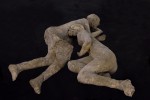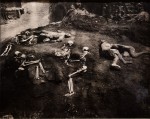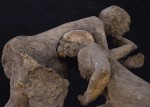 An ongoing project to CT scan the plaster casts of the victims of the eruption of Vesuvius in 79 A.D. has revealed that the cast of two embracing figures known as The Two Maidens are in fact men. The skeletal remains of the couple and the cavity in the volcanic rock left by the decay of their soft tissues were discovered in the garden of the House of the Cryptoporticus in a 1914 excavation overseen by Pompeii’s director of works Vittorio Spinazzola. The remains of eight people were found in that little peristyle garden, two of them in 1913, the rest between July 2nd and 21st of 1914.
An ongoing project to CT scan the plaster casts of the victims of the eruption of Vesuvius in 79 A.D. has revealed that the cast of two embracing figures known as The Two Maidens are in fact men. The skeletal remains of the couple and the cavity in the volcanic rock left by the decay of their soft tissues were discovered in the garden of the House of the Cryptoporticus in a 1914 excavation overseen by Pompeii’s director of works Vittorio Spinazzola. The remains of eight people were found in that little peristyle garden, two of them in 1913, the rest between July 2nd and 21st of 1914.
 All eight were found in the fine ash layer that followed the pumice fall, encased by the pyroclastic flow that covered the town. Plaster casts were made of three of the eight (the right conditions for creating the casts are rare; out of more than 1,100 human remains found at Pompeii, casts have been made of only 86 of them), with particular attention paid to the more complex problem of the couple. The Two Maidens were erroneously assumed to be women because of their posture and the shapeliness of their legs. Here is how Spinazzola described the find in the yearly report on the excavation (translation mine):
All eight were found in the fine ash layer that followed the pumice fall, encased by the pyroclastic flow that covered the town. Plaster casts were made of three of the eight (the right conditions for creating the casts are rare; out of more than 1,100 human remains found at Pompeii, casts have been made of only 86 of them), with particular attention paid to the more complex problem of the couple. The Two Maidens were erroneously assumed to be women because of their posture and the shapeliness of their legs. Here is how Spinazzola described the find in the yearly report on the excavation (translation mine):
One of the fallen lies on the left side, the head pointing to the east and the legs, a bit contracted, to the west. The left hand is folded near the head, in the ashes, and the right is under the chin as if to push away something obstructing the mouth and preventing breathing. The other person is bent on the right side with his head on the breast of the first. And this pose against the abdomen of the first fallen, the right arm buried in the ashes, the left gently bent under the breasts, the legs with full and tender female contours, one more, one less contracted, as of someone sweetly reclining to sleep an eternal sleep in a protective womb.
Apparently seeking comfort in the face of apocalyptic death was deemed to be a feminine impulse rather than a human one. The supposed “female contours” of the legs and later descriptions of “little rings” found on the fingers were extensions of that assumption.
 Examination of osteological and morphological features on the CAT scan indicates that both individuals are male and that the individual with his head against the chest of the other was a young man about 18 years old at the time of death. The other person is believed to be an adult male who was at least 20 years old when Vesuvius claimed his life. Mitochondrial DNA extracted from one tooth and bone fragments established conclusively that the younger of the two was male. DNA analysis confirmed that the two were neither brothers nor father and son. Some news stories have leapt to the conclusion that they were therefore lovers, which is not remotely supportable by the evidence and seems to me just another iteration of the same prejudices that caused the original Two Maidens error.
Examination of osteological and morphological features on the CAT scan indicates that both individuals are male and that the individual with his head against the chest of the other was a young man about 18 years old at the time of death. The other person is believed to be an adult male who was at least 20 years old when Vesuvius claimed his life. Mitochondrial DNA extracted from one tooth and bone fragments established conclusively that the younger of the two was male. DNA analysis confirmed that the two were neither brothers nor father and son. Some news stories have leapt to the conclusion that they were therefore lovers, which is not remotely supportable by the evidence and seems to me just another iteration of the same prejudices that caused the original Two Maidens error.
 The scans are part of the Great Pompeii Project, an extensive program of architectural restoration and stabilization of the most endangered features of the ancient city. The 86 human casts, the oldest of which date to the 1860s when pioneering archaeologist Giuseppe Fiorelli first filled a cavity with plaster to capture the final death throes of one of Vesuvius’ victims, are in need of restoration as much as the buildings are, and they pose a thorny challenge since they contain human remains. In order to get a clear idea of what’s inside the plaster shell — bones, metal supports, more plaster in varying states of decay — conservators borrowed a state-of-the-art 16-layer CT scanner that was able to penetrate the dense materials.
The scans are part of the Great Pompeii Project, an extensive program of architectural restoration and stabilization of the most endangered features of the ancient city. The 86 human casts, the oldest of which date to the 1860s when pioneering archaeologist Giuseppe Fiorelli first filled a cavity with plaster to capture the final death throes of one of Vesuvius’ victims, are in need of restoration as much as the buildings are, and they pose a thorny challenge since they contain human remains. In order to get a clear idea of what’s inside the plaster shell — bones, metal supports, more plaster in varying states of decay — conservators borrowed a state-of-the-art 16-layer CT scanner that was able to penetrate the dense materials.
With the scans as guides, the team was able to extract mitochondrial DNA (which survives far better than nuclear DNA in archaeological contexts) from the skeletal remains with pinpoint precision and minimal damage. This opens up a whole new arena of information about the people of Pompeii.